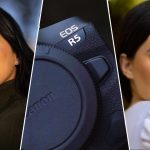In this review, we’ll have a look at a tiny budget camera, called the Canon M200. We’ll explore what it can do, what it can’t do, and we’ll also talk about some of the glaring issues that it has.
Let’s begin.

Size & Build
So first off, let’s have a look at its size. As you can tell, this camera is tiny, and it’s definitely intended for people who just want something small to take photos with, or vlog with.
Instead of carrying something like my Canon R, or even R5, you can just whip this out of your bag, and start filming. Whether it’s actually good for vlogging or not, we’ll discuss this a bit later on in the review.
So, in terms of its physical size, this camera measures 108.2 x 67.1 x 35.1mm, or 4.26 x 2.64 x 1.38″, and weighs in at 299g, or 10.55oz.
Next up, how good is the image quality?
Image Quality
Well, this does depend in part on the lens that you’re using. In terms of the camera itself, it has a 24.1MP APS-C sensor, which measures 22.3 x 14.9mm.
In terms of processor, the Canon M200 has the DIGIC 8, which allowed Canon cameras to film 4K videos at up to 30fps. Additionally, it also improved Canon’s Dual Pixel AF.
There are a few caveats here, in terms of 4K and the Dual Pixel AF, but we’ll go into detail a bit later on in the review.
In terms of ISO, this camera can go from 100, to 25600. When filming in 4K, you can go from 100 to 6400, and when in 1080p, you can do 100 to 12800.
What if you want to capture some wildlife, or sports? The shutter can go as fast as 1/4000th of a second, which is great, but when in continuous mode, you can only do 6.1fps.
Sometimes, when you want to capture some fast motion, you basically want to take as many photos as possible, in a quick burst, in the hopes that you get that one shot that you need.
In the case of the Canon M200, it can capture 6.1 photos within the span of one second. For the price, it’s not bad, to be honest.
What about autofocus? You get up to 143 AF points, depending on which lens you are using, and you have Dual Pixel AF, with Eye Tracking. However, as mentioned earlier, there are some caveats, which I’ll explore in the Video section of this review.
Now that I’ve covered some of the technical aspects of the image quality, here are some photos I took with it.

Video
So let’s discuss what this camera can do in terms of video. You can do 4K, at up to 25fps, 1080p at up to 60fps, and 720p, at up to a whopping 120fps.
Most people won’t really want to film at 720p, though you can get some great footage with it, if you know what you’re doing.
So, I mentioned earlier that there’s an issue with the 4K. First off, when shooting in 4K, you get a 1.7x crop, which is quite zoomed in.
This isn’t ideal if you’re looking to get some wide shots. Also, in 4K you do not have Canon’s legendary Dual Pixel AF. It will still autofocus, but not quite as well as it will do in 1080p, which does allow you to use Dual Pixel AF.
Also, there is a caveat when it comes to the 720p at 120fps, and that is that when in that mode, you cannot record sound, and you also lose access to autofocus.

Vlogging
Now, given its size, you’d imagine that this Canon camera is designed for vlogging. So, is it actually any good at that?
Yeah, it can be quite good for that, but it does have some issues that you need to be aware of.
First off, when deciding between 4K and 1080p, I’d recommend you just stick with 1080p. You don’t get the crop, so you can see more of yourself in frame, especially if you use the 15-45mm kit lens. By shooting in 1080p, you’ll also retain access to the Dual Pixel AF, so your face will be out of focus less often.
You get the 3″ flippy screen on the back, which is fantastic, as it is touch-sensitive, and you now also get a record button on the screen, so you don’t have to press record, and then turn the camera around.
One of its issues when it comes to vlogging is that you can not connect an external microphone to it. It does not have a port for it, so you’ll have to use the built-in mic. To be fair, the built-in mic isn’t bad, and as long as you’re fairly close to the camera, you’ll get decent audio, especially if you’re just getting started with vlogging.
Compatible Lenses
Since I mentioned the kit lens earlier, which lenses is this camera actually compatible with? So it has an EF-M mount, which means that, by default, it can only take EF-M lenses.
You can purchase an EF-EOS M adaptor though, which will allow you to greatly expand your options when it comes to lenses.

YouTubers
Ok, so if it can use loads of different lenses with that adaptor, is this camera good for content creation?
Sure. I’d still stick with the 1080p, due to the enhanced autofocus, but yeah, if you use the adaptor, you can even mount something like a Canon EF 50mm f1.4 or f1.8 on it, and really get some beautiful background blur.
The problem you’d run into with this, is the fact that you’re stuck with the built-in mics, so the further away you are from the camera, the lower the quality of the audio will be.
In order to avoid this issue, you could of course record your audio separately using an audio recorder, and you could then sync up the audio in post.
It’s a bit more of a hassle, but it is an option that you have available to you.
I’ve actually reviewed both of the Canon EF 50mm lenses mentioned earlier,and many others, if you want to watch them you can check out my playlist on my YouTube channel.
Control
So, how easy is this camera to control? While you do have some buttons, the camera seems mainly designed to be used via the touch screen.
This should be fairly intuitive if you’ve taken a lot of photos and videos with your phone.
Storage
What about storage? Does it have a dual SD card slot? Nope, just the one, which is to be expected at this price point. More expensive cameras can have two, which allows you to do backups on the go basically, but in the case of this camera, and budget cameras in general, you only get one.

Connectivity
What about connectivity? You actually have both Bluetooth and Wi-Fi connectivity. This isn’t something that I personally use, as I enjoy the process of taking out the SD card, and plugging it into my laptop, but you do have wireless options, if you should choose to use them.
Battery Life
Ok, so this camera’s pretty versatile then. How long will the battery life last?
With a new battery, you’ll theoretically get 315 shots before the Canon LP-E12 battery runs out of juice. This isn’t great for professional shoots, but if you want to take some photos here and there, or vlog occasionally, this would be quite sufficient.
You can always get some spare batteries, if need be.
Longevity
Right, so if I get this camera, how long will it actually last me? Well, because cameras are mechanical in nature, and they have moving parts, they’re rated for a certain number of photos.
The Canon M200 is rated at around 100,000 actuations, which basically means that you can take 100,000 photos with it, before the shutter theoretically fails.
If you take an average of 10 photos per day, the shutter should theoretically last you about 27 years. Not saying it will, or that other parts of the camera won’t fail before that, but yeah, that’s quite a lot.
If you’re buying this camera second-hand, make sure to check how many photos it’s already taken. People will usually list that info, but you should ask if they haven’t.
Conclusion
And now, the conclusion, who is this camera for, and should you buy it?
So I’d say that this camera is designed for people who want something compact, on the go, which they can use to take some decent photos, and also vlog.
It’s nowhere near as professional and capable as many other more expensive cameras, but this is a budget camera designed with portability in mind. For the price, I’d say it can do some great things, especially if you’re just getting started with content.
You can basically use it for anything from portraits and landscape photos, to vlogging, and street photography. In fact, it’s probably quite good for street photography, as this camera doesn’t look super pro, so you’ll draw a lot less attention.
If you want a camera that does a little bit of everything, for a decent price, but you don’t really care about 4K that much, I’d say this camera is for you.
Which?
If you’ve already learnt a bit about photography and videography, and you’d like to graduate to something more mid-range, feel free to have a look at the camera review playlists on my channel. You can find links down below, or click the card in the top right corner.
I’ve reviewed all sorts of cameras, from the Canon 77D and 7D MkII, to the Canon R, and Canon R5.
If you’d like to purchase any of the items I’ve mentioned in this article, or see how much they cost in your country, I have a link down below where you can view them.
Thank you for reading my review of the Canon M200. I invite you to have a look at some of my other articles. We have something for everyone, whether you’re interested in audio, or cameras and lenses. Alternatively, if you prefer video reviews, feel free to have a look at my YouTube channel.
Product Links
Down below you will find all of the items I talked about in this article.



